Trong bài viết dưới đây, Vietop mang đến các bạn phần bài mẫu giới thiệu về Việt Nam bằng tiếng Anh – một chủ đề khá quen thuộc trong những đề thi tiếng Anh và cũng có thể các bạn sẽ gặp dạng đề này trong kỳ thi IELTS gần đây.
1. Dạng đề giới thiệu về Việt Nam bằng tiếng Anh
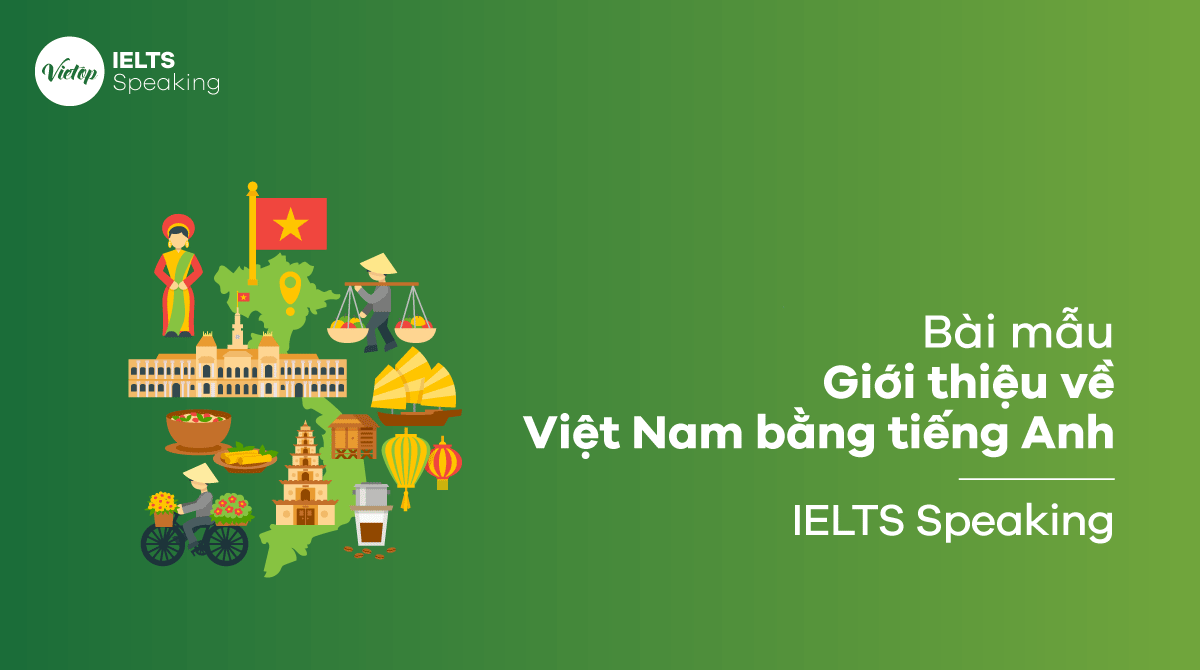
Dạng đề giới thiệu về Việt Nam bằng tiếng Anh sẽ yêu cầu thí sinh có bài viết trình bày hoặc bài nói, giới thiệu về đất nước Việt Nam. Trong phần IELTS Speaking cũng xuất hiện dạng đề này với khá nhiều khía cạnh khác nhau, như Describe a part of your country that you find interesting, Describe a holiday in your country, Describe a tourist attraction that you have visited, Describe a good law in your country, etc …
Ngoài ra, bạn sẽ có thể gặp dạng đề giới thiệu về Việt Nam bằng tiếng Anh ở khắp nơi, không chỉ gói gọn trong đề thi tiếng Anh nói chung và IELTS nói riêng.
Ví dụ như khi gặp gỡ và trò chuyện với đồng nghiệp, khách hàng hoặc bạn bè người nước ngoài, bạn sẽ được hỏi về đất nước của mình chẳng hạn. Khi đó, chuẩn bị cho mình ý tưởng về chủ đề giới thiệu về Việt Nam bằng tiếng Anh chắc chắn sẽ rất hữu dụng.
Sau đây, Vietop mời các bạn đến với phần dàn ý và bài mẫu giới thiệu về Việt Nam bằng tiếng Anh.

Nhận tư vấn miễn phí khóa học hè
2. Dàn ý giới thiệu về Việt Nam bằng tiếng Anh
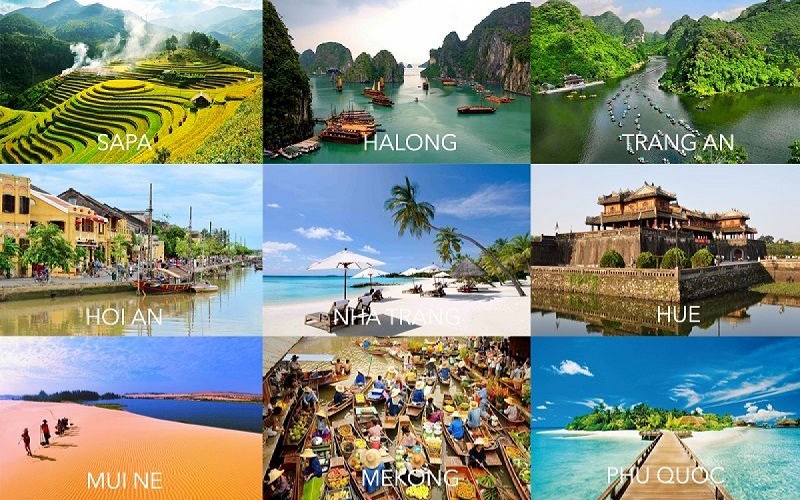
- Vị trí địa lý và khí hậu: thuộc Đông Nam Á, thủ đô là Hà Nội, có khí hậu nhiệt đới gió mùa, quanh năm nóng ẩm và nổi tiếng là nước xuất khẩu gạo lớn thứ 2 thế giới. Miền Bắc có 4 mùa, miền Nam có mùa khô và mùa mưa.
- Địa hình: hình chữ S, ¾ địa hình là núi, nhưng chủ yếu là đồi núi thấp với 3260 km đường biển, đồng bằng rộng lớn và nguồn tôm cá phong phú.
- Con người: Cả nước có 54 dân tộc anh em, trong đó dân tộc Kinh là dân tộc lớn nhất. Nét tính cách truyền thống là lòng yêu nước, tinh thần đoàn kết, coi trọng tình nghĩa, cần cù, hiếu học.
- Lịch sử: Việt Nam có bề dày lịch sử nghìn năm văn hiến với các cuộc chống giặc ngoại xâm, là đất nước có truyền thống đoàn kết, kiên cường bất khuất.
- Văn hóa & ẩm thực: Đặc sắc với nhiều phong tục tập quán, lễ hội thú vị, thể hiện nét văn hóa, ấn tượng riêng. Ví dụ như lễ Tết, tâm linh đền chùa.
- Danh lam thắng cảnh, những địa điểm du lịch nổi tiếng: Sapa, vịnh Hạ Long, Ninh Bình, cố đô Huế, Hội An, động Phong Nha, Quy Nhơn, biển Nha Trang, Phan Thiết, đảo Phú Quốc, Sài Gòn (TPHCM), etc.
3. Bài mẫu giới thiệu về Việt Nam bằng tiếng Anh
Tùy theo chủ đề được yêu cầu mà bạn sẽ giới thiệu tổng quát hoặc từng phần về đất nước Việt Nam.
3.1. Bài mẫu 1: Giới thiệu về Việt Nam bằng tiếng Anh (tổng quát)
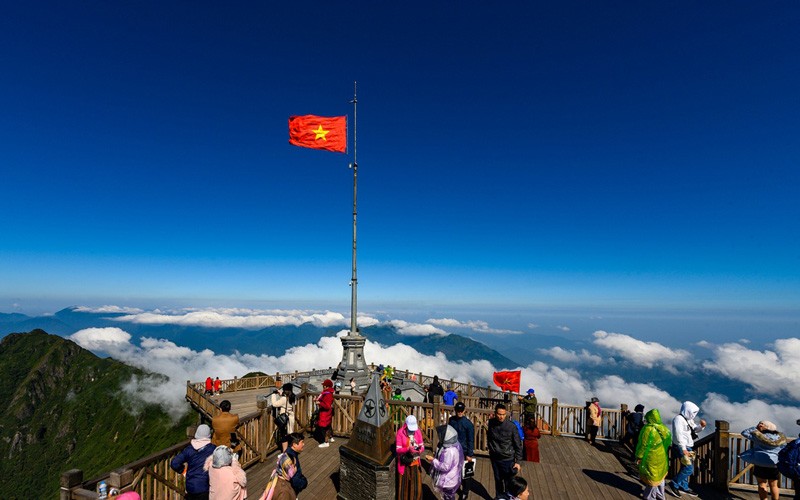
Mời mọi người nghe Audio – Giới thiệu về Việt Nam bằng tiếng Anh (tổng quát) tại đây nhé!
Located in Southeast Asia, my motherland Vietnam is a small and beautiful country with a victorious history, profound patriotism and wonderful landscapes, with Hanoi as its capital. Although my country is ravaged by a series of wars which causes serious damages, Vietnam in the eyes of the world is still nice and peaceful.
Since July 2, 1976, the Socialist Republic of Vietnam has been the official name of my country. Currently, Vietnam is a socialist state with a single political party, the Communist Party of Vietnam.
As a nation of 54 ethnic groups, Vietnam has a vibrant culture rich in traditional customs and cultural identities. Religions such as Confucianism, Taoism, Buddhism, Roman Catholicism, and Cao Dai have had a significant impact on Vietnamese culture. Most Vietnamese people believe they are atheists, but they visit temples and pagodas every year to pray for good fortune and happiness.
Since ancient times, a large number of ancient temples and pagodas have been built throughout the country. In Vietnam, there is a perfect balance of ancient and modern architecture.
Despite the influence of Chinese, French occupation, and American intervention, Vietnam has been left with a vivid legacy from various cultures, which can be seen in the character of its towns, as well as in the architecture and food. Hoi An ancient town, once a major trading port, retains complete architectural influences of Asian merchants, whereas Hanoi and Ho Chi Minh City’s broad boulevards are reminiscent of France.
Furthermore, Vietnam is one of the countries that place a high value on major holidays, festivals, and rites of passage. Tet Nguyen Dan is Vietnam’s most important festival (Tet). There are many rites in Vietnam, such as the birth of a child, engagement, marriage, funeral, and ancestor’s death anniversary. All of these characteristics contribute to Vietnam’s distinct cultural identity.
3.2. Bài mẫu 2: Giới thiệu về Việt Nam bằng tiếng Anh (ẩm thực: phở)
Mời mọi người nghe Audio – Giới thiệu về Việt Nam bằng tiếng Anh (ẩm thực: phở) tại đây nhé!
When talking about the traditional food of Vietnam, Pho is essentially our country’s signature dish, comprising rice noodles in a flavourful soup with meat and various greens, plus a side of chili sauce.
A basic bowl contains beef or chicken, topped with bean sprouts, lime wedges, and fresh herbs such as basil, mint, cilantro, and onions. Depending on the restaurant or roadside stall, you can also opt for more exotic ingredients such as beef tendon or sach thinly-sliced pig stomach, and ve don (flank with cartilage). Typically eaten for breakfast, pho is priced from VND 35,000 at a local restaurant or street market in Vietnam.
Pho has shown its position not only in Vietnamese cuisine but also in world cuisine. This dish can be found everywhere from street stalls to high-end restaurants.
Luyện tập IELTS Speaking với bài mẫu IELTS Speaking part 2 và IELTS Speaking part 3 nhé!
3.3. Bài mẫu 3: Giới thiệu về Việt Nam bằng tiếng Anh (danh lam thắng cảnh)
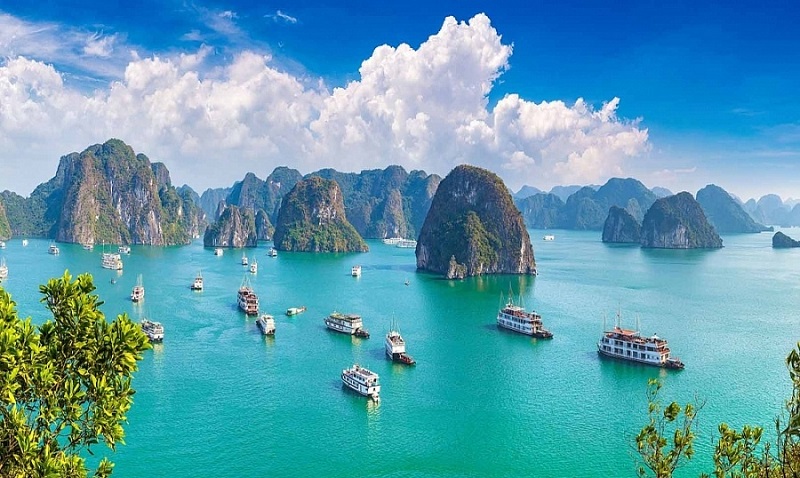
Mời mọi người nghe Audio – Giới thiệu về Việt Nam bằng tiếng Anh (danh lam thắng cảnh) tại đây nhé!
Vietnam is a charming country with a diverse range of breathtaking landscapes, many of which have been designated as UNESCO World Heritage Sites and national treasures. You can travel and enjoy hundreds of signature tourist attractions from Northern mountainous areas to the Mekong Delta, and if you’re interested in discovering the local mountainous lifestyle and breathtaking scenery, Sapa is a must-see.
The highest mountain in Vietnam, Fansipan Mount, is situated in Sapa, Lao Cai province. My initial impression of Sapa was that it was a foggy town with cool weather and fresh air. When visiting Vietnam, a large number of foreign tourists from all over the world are drawn there. From Hanoi, they can travel there by bus, train, or even motorcycle.
Many ethnic minorities, including the Hmong, Muong, Thai, Tay, Nung, and Dao, call Sapa home. These groups have their own special practices and cultural traditions. It will be great if you can stay in a homestay – where you can discover and learn about the local culture.
The locals are incredibly kind and sincere. You can participate in a variety of activities to experience the true mountain lifestyle, including planting rice in terraces, caring for castles, and creating beautiful handicrafts. Additionally, Fansipan can be climbed to the top.
I advise you to visit there because it is one of the best experiences. Additionally, Sapa’s climate makes it the ideal choice for you to unwind after a long day of work. In one day, you can experience all four seasons. Autumn is chilly in the morning, spring is after sunrise, summer is in the afternoon, and winter is chilly at night. These factors combine to make Sapa a top destination for tourists from other countries who want to learn about Vietnamese culture.
If you ever have a chance, travel to Sapa, one of Vietnam’s best natural landscapes, and enjoy the feeling of conquering the roof of Indochina there.
Xem thêm:
3.4. Bài mẫu 4: Giới thiệu về địa lý Việt Nam bằng tiếng Anh
Mời mọi người nghe Audio – Giới thiệu về địa lý Việt Nam bằng tiếng Anh tại đây nhé!
Vietnam, officially known as the Socialist Republic of Vietnam, is a Southeast Asian country located on the eastern edge of the Indochina Peninsula. It shares borders with China to the north, Laos to the northwest, and Cambodia to the southwest. To the east, Vietnam is bordered by the South China Sea, which plays a significant role in its geography and economic activities.
Vietnam’s topography is diverse and characterized by mountains, hills, plateaus, and coastal plains. The country is often divided into three main geographical regions:
- Northern Vietnam: This region is dominated by the Red River Delta, where the Red River flows into the Gulf of Tonkin. It is known for its lush rice paddies and fertile farmland. Northern Vietnam is also home to the country’s capital, Hanoi, and the iconic limestone karst landscapes of Halong Bay.
- Central Vietnam: The central region features the Annamite Range, a series of rugged mountains running parallel to the coastline. It is known for its scenic beauty and historical significance, with cities like Hue and Hoi An showcasing the country’s rich cultural heritage.
- Southern Vietnam: The southern part of Vietnam is characterized by the Mekong Delta, a vast network of rivers, swamps, and islands. This delta is one of the world’s most fertile agricultural regions and plays a crucial role in Vietnam’s economy. Ho Chi Minh City, the country’s largest city, is located in the southern region.
Vietnam’s coastline stretches over 3,200 kilometers (2,000 miles), and it is home to numerous beautiful beaches and coastal areas. The South China Sea, which borders Vietnam to the east, is also significant for its strategic and economic importance.
The country’s geography has influenced its climate, with a tropical monsoon climate prevailing throughout most of Vietnam. There are distinct wet and dry seasons, with variations in temperature and rainfall across the regions.
In summary, Vietnam’s geography is marked by its diverse landscapes, including mountains, deltas, and a long coastline along the South China Sea. This geographical diversity has played a vital role in shaping the country’s culture, economy, and way of life.
3.5. Bài mẫu 5: Giới thiệu văn hóa Việt Nam bằng tiếng Anh
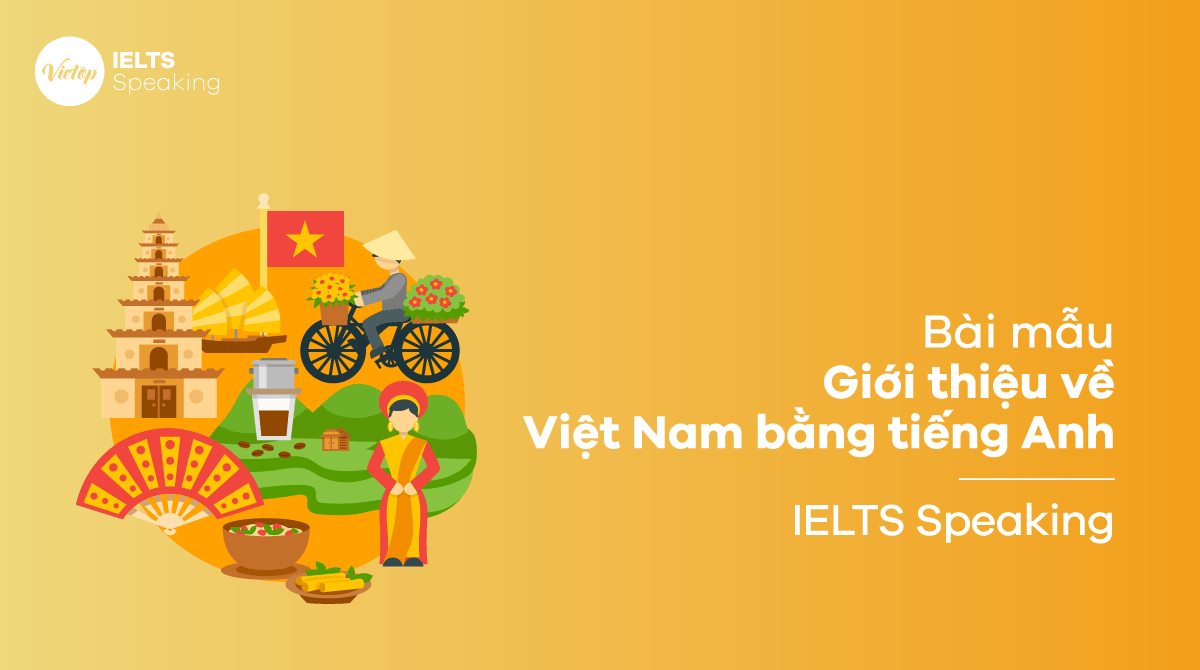
Mời mọi người nghe Audio – Giới thiệu văn hóa Việt Nam bằng tiếng Anh tại đây nhé!
Vietnamese culture is a fascinating blend of tradition, diversity, and enduring values that have evolved over thousands of years. This rich cultural tapestry is deeply influenced by the country’s history, religion, and ethnic diversity.
Language: Vietnamese is the official language and the cultural linchpin of the nation. While English is becoming more prevalent, especially in urban areas, the Vietnamese language remains at the heart of cultural identity and communication.
Family and Respect: Vietnamese society places a strong emphasis on family and respect for elders. Family is considered the cornerstone of Vietnamese culture, and familial bonds are cherished. Confucian values, such as filial piety, shape these traditions.
Cuisine: Vietnamese cuisine is celebrated globally for its freshness and complexity of flavors. Dishes like pho (noodle soup), spring rolls, and banh mi (Vietnamese sandwich) reflect the culinary diversity of the country. Meals are often communal affairs, emphasizing social connections.
Festivals: Vietnam boasts a wide array of festivals, many based on the lunar calendar. Tet, the Lunar New Year, is the most significant festival, marked by reunions, special foods, and traditions like giving lucky money to children.
Traditional Dress: The “ao dai,” a graceful, long tunic with loose trousers, is the traditional dress that symbolizes Vietnamese elegance. It’s commonly worn on formal occasions and represents cultural pride.
Art and Crafts: Vietnamese art encompasses traditional paintings, lacquerware, silk embroidery, and ceramics. Water puppetry, a unique art form, features puppet shows performed on water to traditional music.
Religion: While Buddhism, Confucianism, and Taoism are influential, Vietnam’s religious landscape also includes Catholicism, indigenous beliefs, and syncretic practices, contributing to its cultural diversity.
Literature and Folklore: Vietnamese literature includes timeless works like “The Tale of Kieu” by Nguyen Du. Folklore and legends, often rooted in the countryside, are cherished and passed down through generations.
Music and Dance: Traditional Vietnamese music employs instruments like the dan bau and bamboo xylophone, while dances often depict rural life and historical stories.
In essence, Vietnamese culture is a treasure trove of traditions and customs that reflect the nation’s complex history and the enduring values of family, respect, and community. It’s a culture that continues to evolve while preserving its unique identity.
Xem thêm:
- Bài mẫu Talk about Tet holiday in Viet Nam – IELTS Speaking part 2
- Tên các ngày lễ bằng tiếng Anh ở Việt Nam và trên thế giới
- Bài mẫu Describe Mid-Autumn Festival – IELTS Speaking part 2
Hy vọng với những chia sẻ trên của Vietop về dàn ý và bài mẫu giới thiệu về Việt Nam bằng tiếng Anh, các bạn đã có thể tham khảo được nhiều từ vựng và ý tưởng hay về chủ đề này. Vietop chúc các bạn học tốt và hẹn các bạn ở những bài viết sau!











